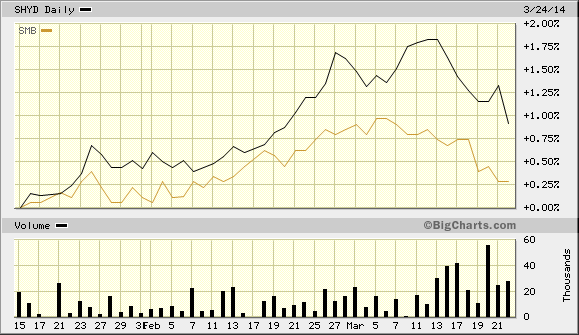Many fear that rising interest rates will crush income-oriented portfolios. Get over it — that was last year’s news. In fact, the vast majority of high-yielding assets have been the best performers of 2014, including utility stocks, REITs as well as long-dated U.S. Treasuries.
Naturally, some investors still wish to hedge against rate risks. What these folks need to recognize is that rising interest rates are currently threatening the short end of the yield curve, not the long end. Safety-seekers have actually bid up the price on longer maturity bonds. It follows that the yield curve is flatter than at any point since October of 2009.
Investors who are wary of getting burned by erratic price swings in longer-term bonds can still hedge against the possibility of the Fed influencing shorter-term rates. The answer? Short-term high yielding municipal bond ETFs.
Here are three reasons that heavily taxed investors ought to look at shorter-term, higher yielding Muni ETFs:
1. Favorable Spread. Earners who feel they are getting fleeced by a 33% or 39.6% tax bracket would be reasonably well compensated for taking on extra risks in higher yielding munis. For instance, the 20-year average yield spread between investment-grade munis and junk-rated munis is usually in the neighborhood of 3%. Right now, that spread is far more favorable at 3.75%. Market Vectors Short-Term High Yield Muni (SHYD) lists a 30-day SEC yield of 4.7% with a taxable equivalent yield for the top tax bracket near 7.75%. Market Vectors  Short-Term Muni (SMB) lists a 30-day yield of 0.92% with a taxable equivalent for the top tier at 1.52%. The reward for pursuing SHYD is worthy of the additional risk.

2. Lower Default Rates. Puerto Rican debt woes spread a dark cloud over higher yielding munis. Yet the default rate for higher yielding munis has been declining. Specifically, the default rate for the S&P Municipal Bond High Yield Index hit 1.5% in 2011. In 2013? The default rate fell to 0.8%. Less defaults combined with greater yield spreads equate to an enhanced risk-reward relationship.

